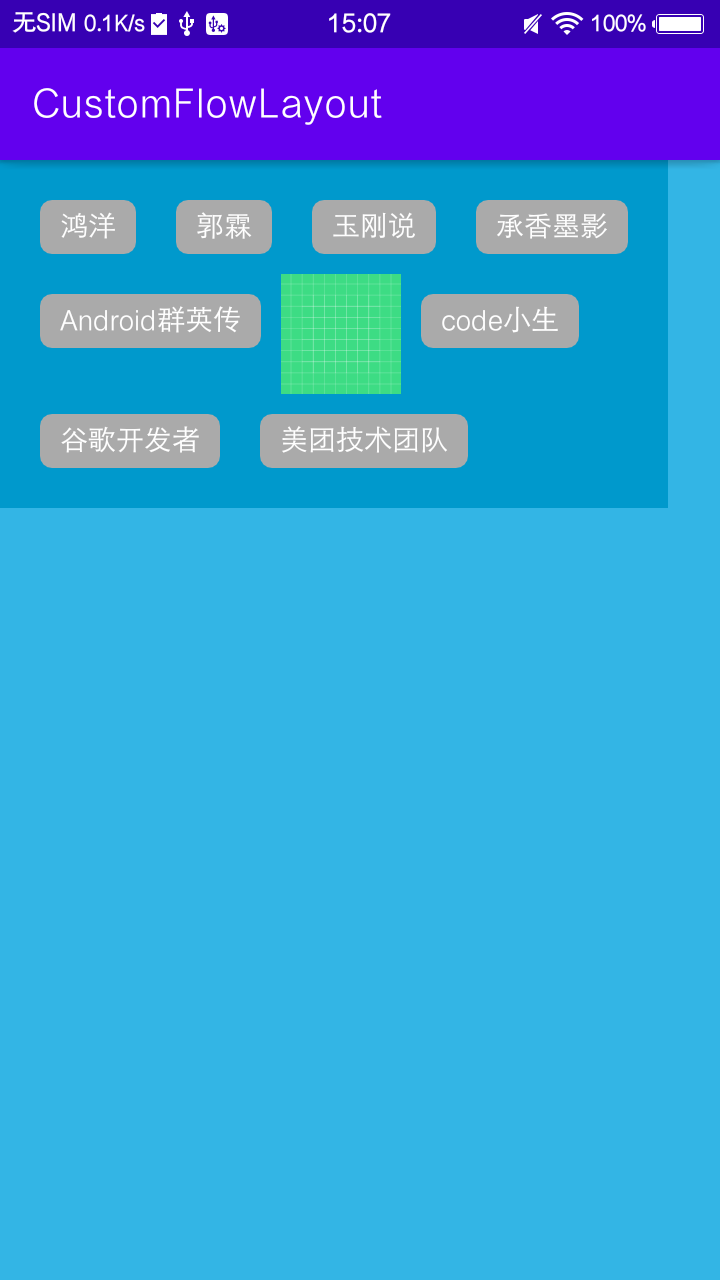Android自定义ViewGroup-入门
1.效果

2步骤
自定义ViewGroup的步骤是
1.1测量onMeasure
/**
* 获取子view的个数
* 逐个测量其宽高 得到整个ViewGroup的宽高
*
* @param widthMeasureSpec
* @param heightMeasureSpec
*/
@Override
protected void onMeasure(int widthMeasureSpec, int heightMeasureSpec) {
super.onMeasure(widthMeasureSpec, heightMeasureSpec);
//获取流式布局的宽度和模式
int widthSize = MeasureSpec.getSize(widthMeasureSpec);
int widthMode = MeasureSpec.getMode(widthMeasureSpec);
//获取流式布局的高度和模式
int heightSize = MeasureSpec.getSize(heightMeasureSpec);
int heightMode = MeasureSpec.getMode(heightMeasureSpec);
//使用wrap_content的流式布局的最终宽度和高度
int width = 0, height = 0;
//记录每一行的宽度和高度
int lineWidth = 0, lineHeight = 0;
//得到内部元素的个数
int count = getChildCount();
mChildPos.clear();
for (int i = 0; i < count; i++) {
//获取对应索引的view
View child = getChildAt(i);
//测量子view的宽和高
measureChild(child, widthMeasureSpec, heightMeasureSpec);
MarginLayoutParams lp = (MarginLayoutParams) child.getLayoutParams();
//子view占据的宽度
int childWidth = child.getMeasuredWidth() + lp.leftMargin + lp.rightMargin;
//子view占据的高度
int childHeight = child.getMeasuredHeight() + lp.topMargin + lp.bottomMargin;
//换行
if (lineWidth + childWidth > widthSize - getPaddingLeft() - getPaddingRight()) {
//取最大的行宽为流式布局宽度
width = Math.max(width, lineWidth);
//叠加行高得到流式布局高度
height += lineHeight;
//重置行宽度为第一个View的宽度
lineWidth = childWidth;
//重置行高度为第一个View的高度
lineHeight = childHeight;
//记录位置
mChildPos.add(new ChildPos(
getPaddingLeft() + lp.leftMargin,
getPaddingTop() + height + lp.topMargin,
getPaddingLeft() + childWidth - lp.rightMargin,
getPaddingTop() + height + childHeight - lp.bottomMargin));
} else { //不换行
//记录位置
mChildPos.add(new ChildPos(
getPaddingLeft() + lineWidth + lp.leftMargin,
getPaddingTop() + height + lp.topMargin,
getPaddingLeft() + lineWidth + childWidth - lp.rightMargin,
getPaddingTop() + height + childHeight - lp.bottomMargin));
//叠加子View宽度得到新行宽度
lineWidth += childWidth;
//取当前行子View最大高度作为行高度
lineHeight = Math.max(lineHeight, childHeight);
}
//最后一个控件
if (i == count - 1) {
width = Math.max(lineWidth, width);
height += lineHeight;
}
}
// 得到最终的宽高
// 宽度:如果是AT_MOST模式,则使用我们计算得到的宽度值,否则遵循测量值
// 高度:只要布局中内容的高度大于测量高度,就使用内容高度(无视测量模式);否则才使用测量高度
int flowLayoutWidth = widthMode == MeasureSpec.AT_MOST ? width + getPaddingLeft() + getPaddingRight() : widthSize;
int flowLayoutHeight = heightMode == MeasureSpec.AT_MOST ? height + getPaddingTop() + getPaddingBottom() : heightSize;
//真实高度
realHeight = height + getPaddingTop() + getPaddingBottom();
//测量高度
measuredHeight = heightSize;
if (heightMode == MeasureSpec.EXACTLY) {
realHeight = Math.max(measuredHeight, realHeight);
}
// 设置最终的宽高
setMeasuredDimension(flowLayoutWidth, flowLayoutHeight);
}
在测量的过程中就可以获取到每一个子控件的位置,直接缓存,在onLayout中可以直接遍历摆放。
private class ChildPos {
int left, top, right, bottom;
public ChildPos(int left, int top, int right, int bottom) {
this.left = left;
this.top = top;
this.right = right;
this.bottom = bottom;
}
}
1.2.摆放onLayout
@Override
protected void onLayout(boolean changed, int l, int t, int r, int b) {
int count = getChildCount();
for (int i = 0; i < count; i++) {
View child = getChildAt(i);
ChildPos pos = mChildPos.get(i);
//设置View的左边、上边、右边底边位置
child.layout(pos.left, pos.top, pos.right, pos.bottom);
}
}
注意:
需要重写generateLayoutParams 返回MarginLayoutParams才可以在onMeasure中获取到控件的Margin值
@Override
public LayoutParams generateLayoutParams(AttributeSet attrs) {
return new MarginLayoutParams(getContext(), attrs);
}
Android自定义ViewGroup-入门的更多相关文章
- android自定义viewgroup之我也玩瀑布流
先看效果图吧, 继上一篇<android自定义viewgroup实现等分格子布局>中实现的布局效果,这里稍微有些区别,每个格子的高度不规则,就是传说的瀑布流布局,一般实现这种效果,要么用第 ...
- Android自定义ViewGroup
视图分类就两类,View和ViewGroup.ViewGroup是View的子类,ViewGroup可以包含所有的View(包括ViewGroup),View只能自我描绘,不能包含其他View. 然而 ...
- Android自定义ViewGroup,实现自动换行
学习<Android开发艺术探索>中自定义ViewGroup章节 自定义ViewGroup总结的知识点 一.自定义ViewGroup中,onMeasure理解 onMeasure(int ...
- android自定义viewgroup实现等分格子布局
先上效果图: 实现这样的效果: 一般的思路就是,直接写布局文件,用LinearLayout 嵌套多层子LinearLayout,然后根据权重layout_weight可以达到上面的效果 还有就是利用g ...
- android 自定义ViewGroup和对view进行切图动画实现滑动菜单SlidingMenu
示意图就不展示了,和上一节的一样,滑动菜单SlidingMenu效果如何大家都比较熟悉,在这里我简单说明一下用自定义ViewGroup来实现. 实现方法:我们自定义一个ViewGroup实现左右滑动, ...
- android 自定义ViewGroup和对view进行切图动画实现滑动菜单SlidingMenu[转]
http://blog.csdn.net/jj120522/article/details/8095852 示意图就不展示了,和上一节的一样,滑动菜单SlidingMenu效果如何大家都比较熟悉,在这 ...
- Android自定义ViewGroup(四、打造自己的布局容器)
转载请标明出处: http://blog.csdn.net/xmxkf/article/details/51500304 本文出自:[openXu的博客] 目录: 简单实现水平排列效果 自定义Layo ...
- android自定义viewgroup初步之一----抽屉菜单
转载请注明出处 http://blog.csdn.net/wingichoy/article/details/47832151 几天前在慕课网上看到鸿洋老师的 自定义卫星菜单,感觉很有意思,于是看完视 ...
- Android 自定义ViewGroup手把手教你实现ArcMenu
转载请标明出处:http://blog.csdn.net/lmj623565791/article/details/37567907 逛eoe发现这样的UI效果,感觉很不错,后来知道github上有这 ...
- Android -- 自定义ViewGroup实现FlowLayout效果
1,在开发的时候,常在我们的需求中会有这种效果,添加一个商品的一些热门标签,效果图如下: 2,从上面效果可以看得出来,这是一个自定义的ViewGroup,然后实现换行效果,让我们一起来实现一下 自定义 ...
随机推荐
- Django中ModelForm详解
1.ModelForm组件介绍:这个组件的功能就是把model和form组合起来 2.ModelForm的使用 1.首先需要导入ModelForm from django.forms import M ...
- activiti数据表介绍
activiti6.0数据库介绍 Acitiviti6.0数据库中一共有28张表,表的命名都是以ACT_开头的.第二部分是一个两个字符用例表的标识. 用于自我学习记录,后期不定期更新~~~ 数据库描述 ...
- ubuntu安装vmware
安装过程: 首先直接将光盘文件中的tar.gz复制到桌面,解压过程如下 中间遇到的问题: 在执行的过程中一直在回车,需要输入的全为yes,还有一个是what is the location of th ...
- Django的model.py
什么是ORM? 对象关系映射 类 >>> 表 对象 >>> 表记录 对象的属性 >>> 一条记录某个字段对应的值 django的orm不能够自动帮 ...
- Django 在test.py 中测试文件的配置
import os import sys if __name__ == "__main__": os.environ.setdefault("DJANGO_SETTING ...
- moviepy音视频剪辑:视频剪辑基类VideoClip的属性及方法详解
☞ ░ 前往老猿Python博文目录 ░ 一.概述 在<moviepy音视频剪辑:moviepy中的剪辑基类Clip详解>和<moviepy音视频剪辑:moviepy中的剪辑基类Cl ...
- Error: Cannot find module '../lib/utils/unsupported.js'
报错: nodejs : Error: Cannot find module '../lib/utils/unsupported.js' 解决办法(linux): 去node目录下:/node***/ ...
- 用python讲解数据结构之树的遍历
树的结构 树(tree)是一种抽象数据类型或是实现这种抽象数据类型的数据结构,用来模拟具有树状结构性质的数据集合 它具有以下的特点: ①每个节点有零个或多个子节点: ②没有父节点的节点称为根节点: ③ ...
- [Windows] 在 Microsoft Docs 网站中挖掘 MVVM 的各种学习资源
最近写了一些 MVVM 框架的文章,翻了一些 Microsoft Docs 的文档,顺便就对 MVVM 本身来了兴致,想看看更多当年相关的文档.在 MVVM 出现后十多年,我在不同的场合见到过多种 M ...
- 谈Vite在Electron环境下吃花卷拉馒头的现象
缘起 在Electron的渲染进程中(也就是页面代码中), 我们常常使用process.env来携带一些环境变量, 比如HTTP服务地址的基质,本地静态资源的路径等 这样做主要有两个目的 一个是方便开 ...
